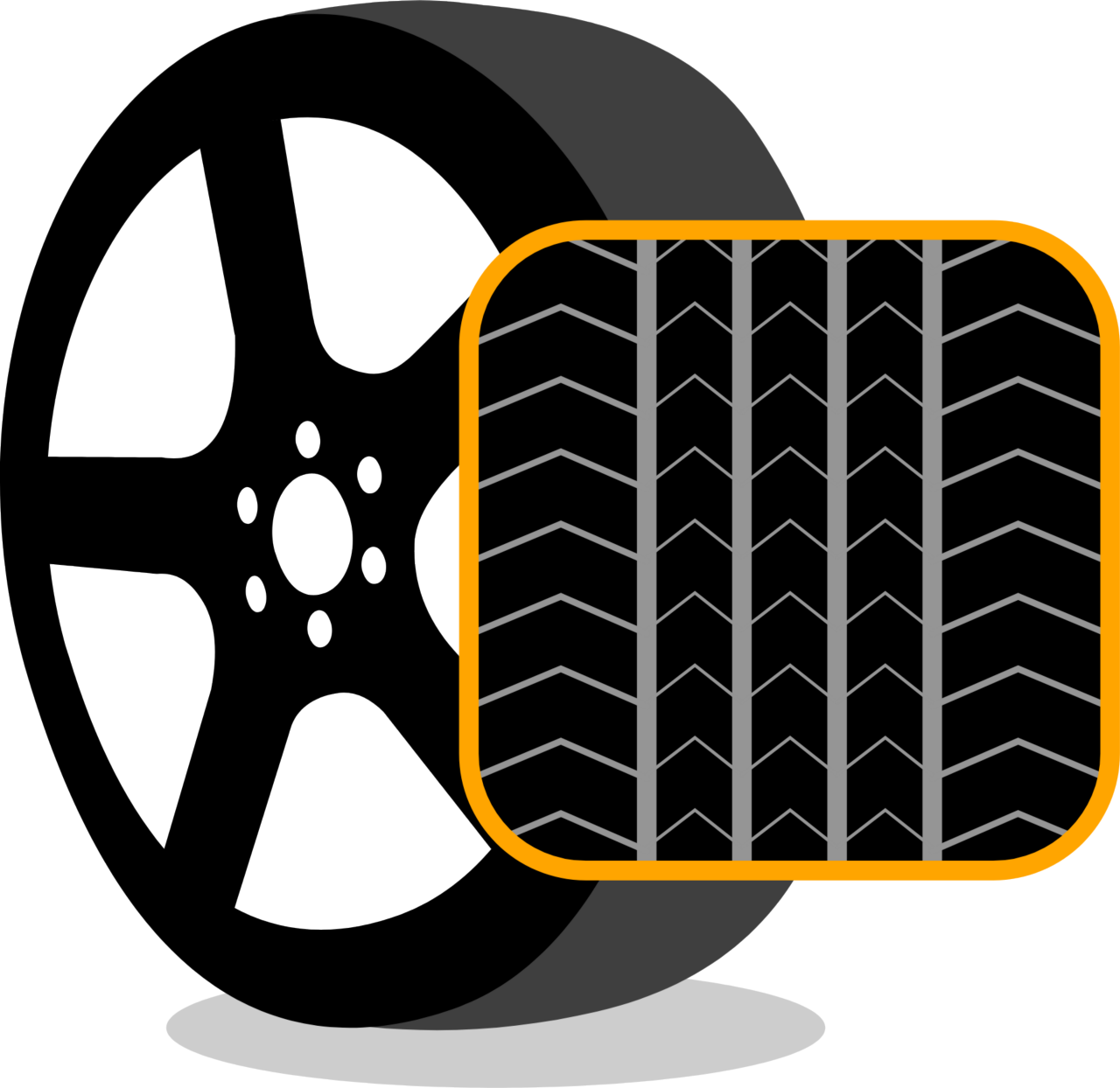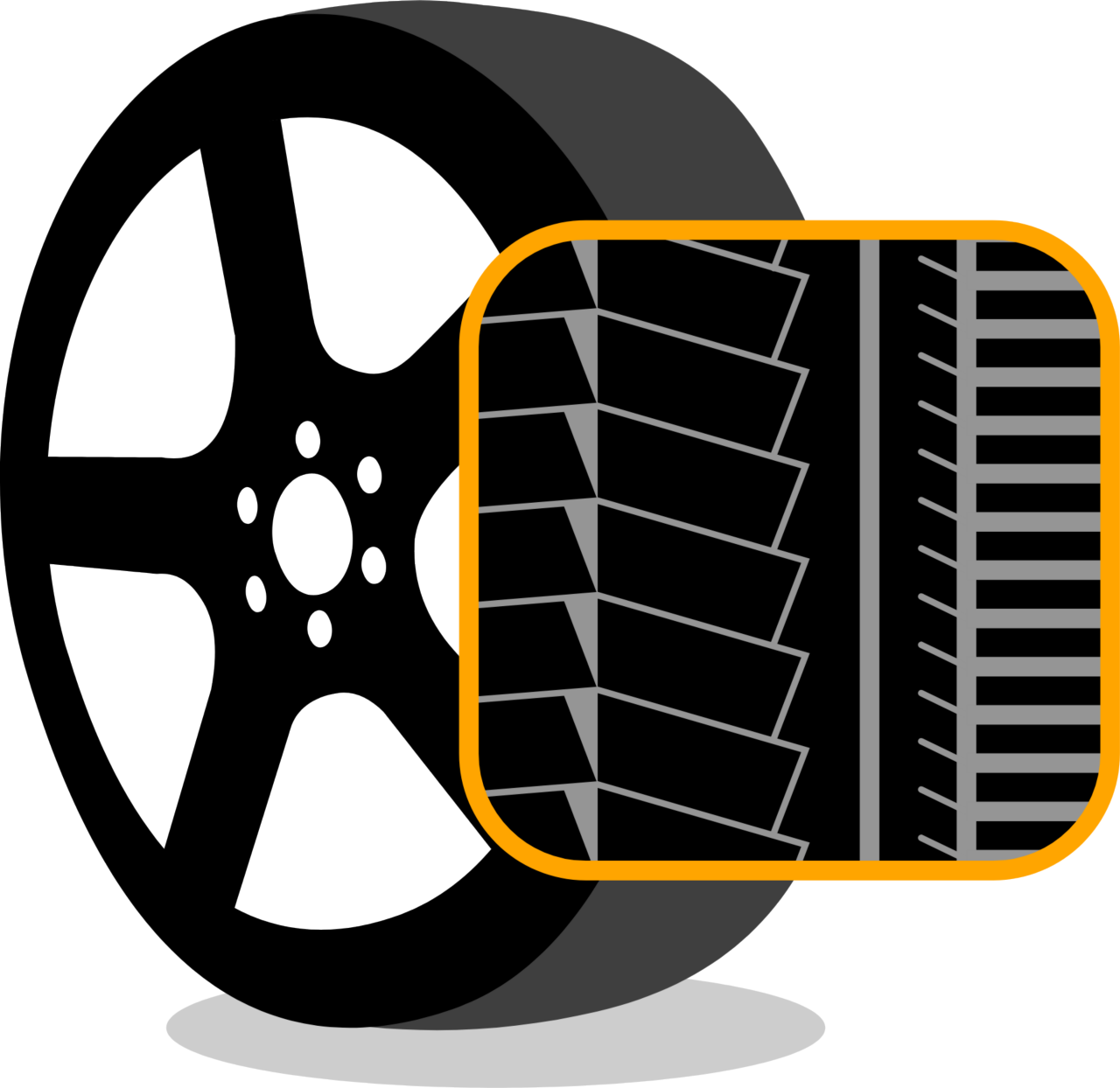
Visit Continental Tires in your country for local vehicle fitment
# Tire Basics
Tire tread
Tire tread patterns and depth
Tire tread patterns explained
The tread is the part of the tire that makes contact with the surface of the road. And if you take a look at different tires on the market, you'll notice a great deal of variety in their tread patterns.
Why are they so different? Because a tread pattern is a unique design that enhances a vehicle with grip and handling for specific driving conditions. Just like in a detective novel, you could identify a make of tire by the tracks it leaves on the road.
Every tire tread has four constituent parts: ribs, grooves, blocks, and sipes. All these parts play a crucial role in providing a safe, efficient, and performative tire.
Ribs
- Ribs are the raised section of the tread pattern, made up of tread blocks.
- They create contact with the road and boost traction.
Grooves
- Grooves are deep channels between tread blocks which run circumferentially and laterally around the tire.
- Grooves make tread blocks flexible and channel away moisture, which can otherwise interfere with the tire’s traction
Blocks
- Tread blocks are the raised rubber segments that make contact with the road surface and directly affect the stability of the tire.
- Tread blocks are also important for acceleration and the braking capabilities of the tire.
- Larger blocks provide more road contact area, which as a consequence enhances the tire’s grip.
Sipes
- Sipes are small, thin slots molded into the tread blocks.
- The sipes take small amounts of moisture as the tires roll and push it out from underneath the tire, increasing traction and the tire’s surface area.
Taken together, the ribs, grooves, tread blocks, and sipes can be arranged in a unique pattern to modulate the tire's performance in critical areas like noise, handling, traction, and wear.
And that in turn provides tire manufacturers with the ability to develop tread patterns to address specific driving needs like wet braking, dry handling, aquaplaning (hydroplaning) resistance, and traction on ice and snow.
How many tire tread patterns are there? Quite a few. But broadly speaking, we can distinguish between three categories of tire tread pattern. Which one does your car have?
Symmetrical tread pattern
The most common type of pattern is symmetrical; it's suitable for passenger car tires, but not for high-performance use. Tires with this design have continuous ribs or independent tread blocks across the entire face of the tread, and both halves of the tire feature the same pattern.
Key features:
- Smooth driving
- High directional stability
- Low rolling resistance
Tires with symmetrical patterns provide the owner of the vehicle with the most flexibility for tire rotation without affecting day-to-day performance. They're also quiet, long-lasting, and fuel efficient. However, they are less adaptable to changing conditions on the road. So even though symmetrical patterns deliver steady grip on a dry road, they won't be as effective in wet conditions as other tires.
Directional tread pattern

A tire with a directional tread pattern is designed to roll forward in one direction only. It has lateral grooves that meet in the middle of the tire tread, resembling the shape of an arrowhead. Its purpose is more than sporty aesthetic, however. The V-shaped grooves are more capable of resisting aquaplaning (hydroplaning) at high speeds by displacing water more efficiently through the tread pattern. Another benefit of directional tread is extra traction, which provides excellent handling on snow or mud.

For this reason, a good all-season or winter tire is highly likely to have a directional tread pattern. The extra traction is also useful for performance tires on high-performance vehicles.
Key features:
- High protection against aquaplaning
- Excellent handling on snow and mud
- Very good road holding at high speed
The point to remember about directional patterns, however, is that tire rotation becomes a bit more complicated. They can only be rotated vertically – for example, from the front of the car to the back – otherwise, the pattern will be oriented in the wrong direction when fitted to a wheel on the other side of the vehicle. That would render the benefits of the tire tread useless.
You can keep track of the correct orientation using the arrow indicator printed on the sidewall of the tire. It's in the same direction as the pattern, pointing in the required direction of travel.
Asymmetric tread pattern
A tire with an asymmetric pattern features two separate tread designs, one on the inner half and another on the outer half of the tire. It looks unusual, but both halves serve a distinct purpose. The inner tire tread is responsible for water displacement and protection against aquaplaning (hydroplaning). The outer tire tread has rigid tread blocks for higher lateral stiffness, which provides high grip when cornering and driving on dry surfaces, and quieter interior noise.

This combination of features makes asymmetrical tires especially popular for use on ultra-high-performance cars.
Key features:
- Excellent handling
- High curve stability
- Good grip in wet conditions
However, just like a directional tire pattern, care must be taken with tire rotation. Vertical rotation between front and back are the options here. Indicators on the sidewall will guide correct fitting.
Can I use different tread patterns on front and rear tires?
When buying new tires, avoid mixing different types, sizes, or brands of tire on a single vehicle. For best results, source the identical make and model of tire to the ones you already have on your wheels, to maintain optimal performance characteristics.
Another thing to keep in mind when replacing tires; We recommend all wheel positions are fitted with tires of the same tread pattern.
As a compromise, replacing a pair of tires is safer than replacing just a single tire. The newest tires should be fitted on the rear axle, and partially worn tires on the front axle.
If this isn't possible, then drivers are advised to ensure that the replacement tire has the same tire tread pattern as the other tire on the same axle. Mixing the patterns will impair the handling characteristics of your car; it could even be dangerous.
Don't forget to check your tire tread depth!
To ensure safe usage and meet specific driving requirements, tread patterns must have sufficient tread depth.
If the tread is not deep enough, your car will lose traction and suffer extended braking times. Shallow tread grooves make it harder to control the vehicle in wet weather and the chance of aquaplaning will increase. To ensure your safety, measure the tread depth as part of your regular vehicle maintenance.
The original tread depth of a new tire can vary depending on the application and type of tire. For example, the tread depth of new winter tires is usually 9/32 to 11/32 inches (7-9 millimeters).
As you drive, the tread will wear down.
If your winter tires have studs, they will also wear down with the tire tread. Keep in mind that 2/32 inches (1.6 millimeters) is the minimum tread depth.
A tire with less tread depth lacks grip. Braking distance and vehicle control are impaired on wet conditions. Tires with a tread depth of less than 1.6 mm are not safe for driving and must be replaced
Please consider that safe driving in wet and snowy weather conditions is affected by the tread depth, the pattern design and the rubber compound of the tread of your tires. On wet or snow-covered roads braking performance will progressively decline with lower tread depths. On wet roads there is an additional increased risk of aquaplaning with fading tread depths.
Therefore, check your tires regularly, reduce your speed on wet and snowy roads and consider replacing your tires in good time.
We also recommend checking your tire pressure once a month
Ensure your vehicle is equipped with the correct winter, summer, or all-season tires.
Tread wear indicators
Wondering how to measure or check the tread depth of your tires? Look at the tread wear indicators or use a tire tread depth gauge.
Tread wear indicators (TWI), or wear bars, are small, raised bars of rubber, spaced evenly through the main grooves in the tire tread. If they are flush with the level of the tread, then the tire should be replaced.
Several winter tire models are equipped with winter tire wear indicators. If they are flush with the level of the tread, the tire is no longer suitable for winter driving conditions. In some locations they may also no longer legally qualify as winter tires. For example, in Austria a tread depth of 4 mm is required for winter tires.

Using a tire tread depth gauge
If you have a tire tread depth gauge, use it to precisely measure the tread depth. Insert the probe bar into the groove and push the shoulders flush with the tread. Check the top of the gauge to see the measurement. Alternately, a small ruler can be used.
Be sure to check in various locations. A misaligned wheel may result in uneven treadwear. Keep an eye open for any areas that look more worn than the surrounding surface. The tire's tread should be judged by the lowest depth you measured.
While measuring the tread, look for cupping, or scalloping. These are small scoops, or divots, carved from the tread. They can indicate misalignment or other problems with your vehicle. Also, watch out for bulges in the tire tread or sidewall.
If you are uncertain of the measurements or notice uneven spots on your tire, take your vehicle to a service center.

Improving performance with the right tire tread patterns
Tire tread patterns play an important role in improving the fuel efficiency of vehicles. Furthermore, they increase the ride comfort. Innovative tread patterns focus on lowering rolling resistance by using features that help maintain the tire's shape and reduce uneven deformation. By using advanced materials and streamlined grooves, they ensure smooth contact with the road. The result: less energy is needed to keep the vehicle moving, leading to better fuel efficiency.
Tire tread patterns are also important for quieter, more comfortable driving: various tread block patterns and noise-canceling technologies are used to significantly reduce tire road noise. This also enhances passenger comfort and creates a more peaceful driving experience, particularly during long trips.
Related content
-
 2024/10/17The modern tire is a complex work of engineering designed to tackle a myriad of challenges. Learn about the different tire types, and their pros and cons.Tire typesRead more
2024/10/17The modern tire is a complex work of engineering designed to tackle a myriad of challenges. Learn about the different tire types, and their pros and cons.Tire typesRead more -
 2024/10/17A modern tire is made from many components. Follow the tire manufacturing process step by step, from raw materials to finished tires.Tire productionRead more
2024/10/17A modern tire is made from many components. Follow the tire manufacturing process step by step, from raw materials to finished tires.Tire productionRead more